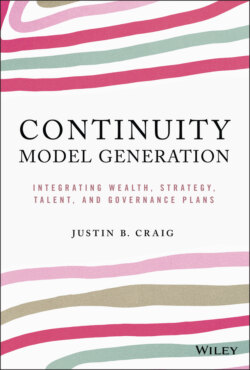Читать книгу Continuity Model Generation - Justin B. Craig - Страница 20
The Big Tent Framework
ОглавлениеAs businesses and families evolve, promoting meaningful involvement and engagement among enterprise members presents a challenge. As one sage family business leader suggests, “entitlement and wealth become the enemy.”
Most families that have effectively addressed the challenge of engagement pursue a big tent approach. It's the idea that family leaders prefer to have the growing number of family members inside the tent, where they are provided appropriate education and other development support for meaningful roles, rather than outside the tent, where they may become suspicious of what's going on inside and even tempted to sabotage it, whether intentionally or not. Thus, a big tent approach sends a strong message, particularly to next-generation members and affines, about their potential value and contributions to the enterprise, and the importance of their involvement (Illustration 8).
But the approach requires careful, strategic orchestration.
Indeed, with an increasing number of families worldwide committed to family governance initiatives, they are in effect developing their own, idiosyncratic big tent approaches. Specifically, they are setting clear guidelines for how family members can engage meaningfully with, and contribute to, the family and its ever more complex and challenging business activities.
In lectures and presentations, when I share my observations of families who pursue the big tent approach, the metaphorical concept usually makes intuitive sense to listeners, no matter the country or audience type. But it's only when I describe what it feels like to be left out of the tent that the message really hits home.
The main example I share is when members of a founding generation explained to me that they wanted their legacy to be a family enterprise that survived across many generations. Immediately after, they stipulated that the wives of their two sons were to be excluded from all business conversations. In response, they were delicately reminded that the spouses were the mothers of their grandchildren, and therefore significant influences on how the third generation would see the business, and thus it may have made sense to “bring them into the tent”; they reconsidered and committed to establish meaningful non-operational roles for their daughters-in-law. Other, similar examples, such as those of affines who are excluded from “family” meetings, also tend to hit home.
Still, inclusion of family members for the sake of inclusion can be interpreted as a token gesture. The key, then, from my observations of insightful multigenerational family businesses, is to ensure that individuals are ready, willing, and capable to contribute in a meaningful way. I must emphasize the tripartite nature of this set of attributes, as implied by the use of the word “and” rather than “or.” That is, the omission of any one of the three qualities—such as being ready and willing but not capable—means potential disaster, or at the very least a far from ideal situation for the family and enterprise. Readiness, willingness, and capability are mandatory qualities for contribution.
This discussion also raises the question of what it means to contribute to the enterprise. Again, observation of families who spend a considerable amount of time getting this right suggests that an ideal way to promote contribution is to design meaningful pathways to contribute. There's no one right set of such pathways, but there are many examples of these types of pathways:
Executive
Manager/supervisor
Enterprise/entrepreneurship
Family office
Family governance
Business governance
Family philanthropy
Each of the pathway-related roles comes with a distinct set of requirements, responsibilities, and remuneration, all of which must be clearly articulated. See again my earlier caveat that all elements of the big tent approach require careful, strategic orchestration.
So how does it all come together?
Back inside the tent, when a family member who does not work in the business understands that there are meaningful ways that they can engage with the enterprise, such as through a family office or business governance role, they are more likely to feel valued. Likewise, a married-in will feel included when they hear about opportunities for involvement in the family's philanthropic activities. Or, when a rising-generation member finds out about the enterprise pathway, they will enthusiastically consider the family business a venture partner they may need in the future to execute their own entrepreneurial vision.
Illustration 8 THE BIG TENT APPROACH
Whatever the exact circumstance, the big tent approach helps the full range of family members to see new opportunities to contribute and to understand the need—and expectation—to have the required skill sets to deliver optimally in a given, appropriate role. That is, they recognize the importance of being ready, willing, and capable to contribute to the enterprise. This thinking is at the core of continuity modelling.
p
